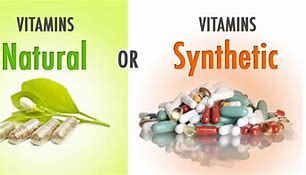A Point of Truth between Natural and Synthetic Vitamins
 Thursday, July 19, 2012 at 10:23AM
Thursday, July 19, 2012 at 10:23AM If (ALL) synthetic vitamins are the same as natural, how would you explain these known facts?
- Some synthetic vitamins breakdown faster in the body than an equal amount of the natural form of that vitamin.
- Some synthetic vitamins are excreted out of the body at an accelerated rate compared to the same amount of natural vitamin.(These may not be observed in all studies, thus the some studies connotation)
- It takes twice as much synthetic vitamin E, dl-alpha tocopheryl, to reach the fetus and develop the same fetal blood levels as half as much natural vitamin E, d-alpha tocopherol.
- Synthetic vitamin E, dl-alpha tocopheryl, is half D'alpha and half L'alpha. D'alpha molecules form to the right, as in nature, but the L'alpha ones form to the left, not found in nature. Thus, the synthetic at best might be only half as effective as natural E. Plus, in the synthetic form, there are a total of 8 stereoisomers of dl'alpha tocopheryl formed, only one of which is exactly the same as in the natural E, the RRR form. The other seven are not found in nature, but three of these other forms beginning with R do have some E activity. RRR (natural), RSR, RSS, RRS and SRR, SSR, SRS. SSS. This is where synthetic gets a small boost over 50% activity compared to natural, thus it is equal to about 68% of natural. This is just regarding alpha tocopherol, not the other 7 vitamin E family members as beta, delta, and gamma tocohperols and the 4 tocotrienols; alpha, beta, delta, and gamma.
- The synthetic form of vitamin K (K3 or menadione) is toxic and not used without medical supervision, while the natural form phylloquinone (K1) can be manmade and called phytonadione. The manmade form is often just 75% similar to the nature made form of phylloquinone, the other 25% being inactive other forms, including the possibility of a little K3, the toxic form. Even vitamin K2 as MK-7 can be synthetic. Make sure natto is listed as source. If no natural source is listed, it could be a synthetic form. Not much information found to compare the two forms yet, but best to stay with the natural natto form.
- When synthetic vitamin E was first produced, testing showed it's activity level was less than the natural form by about 32%. To compensate for this, Scientist used about 1.36 milligrams of the synthetic material to match the activity of 1 milligram of natural and called the two equal. Since one unit of vitamin E was given to the synthetic form, only .67 units of natural E would equal it. But these amounts were determined using a dog study and for only one function of vitamin E. The activity of synthetic E could be even less in humans. The measurement test of fetal blood vitamin E levels somewhat questions this percentage aspect. Does that sound like they are equal?
- Natural beta carotene contains at least 3 forms, all-trans-, 9-cis-, & 13-cis, while the synthetic has only one form, all trans-. In theory, all-trans-beta carotene is able to convert into the other two forms and they can also convert into the all-trans form when needed. But, tests have revealed that while the 9-cis and 13-cis forms are quite willing to convert to all-trans, the all-trans form is rather stingy and does not share this altruism. Yes, it is the major form. But it may not be wise to rely on the body for this conversion since some important functions require both the 9-cis and all-trans forms to unite together.** article Supplements of D. Salina algae contain all forms the same as many vegetables and fruits. article
- In case you haven't notice yet, this discussion has only mentioned the fat soluble vitamins, especially A as beta carotene, Vitamin D, vitamin K, and vitamin E.
- The water soluble B complex and vitamin C are not so much different from their synthetic versions, but there are a few differences. For vitamin C. A few minor ones (1,2 above) to be noted later and one major, folic acid. The body might sense a difference while science doesn't see it yet and this explains why the body speeds up breakdown and elimination of synthetic forms. At 500 mg, supplemental vitamin C exhibits a significant reduction in absorption. Or, it could just be due to often higher dosage, combining element, or isolation from food elements synergism. (above 200mg of C intake, urine outflow of C increases)

- The reason that most of the natural B vitamins, with exceptions for folate and vitamin B12, are nearly identical to their synthetic counterparts is simple a matter of similar structures and absorption methods. Yes, synthetic B vitamins are combined with different carriers than the ones found in food, but this is not that much of a factor since in the stomach and intestines, the vitamin part separates from the compound carrier and enters into the body in a free form. Example, Thiamine HCL is synthetic, while thiamine in food forms as TPP, plus a few more forms.* These are mainly separated to just free form thiamine which have identical structures. The HCL and TPP enter the body separately, perhaps also getting separated to parts, and then either used or eliminated out of body. While synthetic thiamine is very close in structure to food formed thiamine, the body does recognize tiny differences between the two as not all functions are the same. Best to consume small dosages of thiamine HCL supplements while getting the lions share from food. Supplements do somewhat help overcome dietary deficiencies. The one B vitamin that has a glearing difference, other than B12, is vitamin B6. Some body process doesn't like higher dosages of the B6 form pyridoxine HCL. It may block out the natural PLP form in the body creating a deficiency. ref
*Explanation from a reference: "Foods may contain TPP, TTP, thiamin monophosphate (TMP), thiamin, thiamin sulfide, thiamin disulfide, thiamin tetrahydrofurfuryl disulfide (sometimes added to wine), thiamin hydrochloride; thiamin is a monovalent cation at physiological pH. The median intake of adult men in the United States is about 1.9 mg/day" Thus, synthetic thiamine HCL (hydrochloric acid) is also found in a few foods, plus, HCL is naturally secreted into the stomach by the body to maintain an acid medium.
SIDEBAR: Vitamin B12 needs a little more clarification. All forms are for the most part mostly natural since they come from natural sources like bacteria and algae or animals. Scientists have yet to be able to completely create totally synthetic vitamin B12. But, the natural vitamin B12 base is manipulated by adding a mineral (often cyanide) at a certain spot through an enzymatic action, similar to how the body can convert the different forms. What is true is that some forms like the typical one used in many supplements, cyanocobalamin, are not found naturally, so many call it synthetic. It should be called semi-synthetic. The body has to convert cyanocobalamin into the preferred natural forms as methylcobalamin, the most commonly used form, and the less used adsenosylcobalamin. ref These are the physiological body forms. There is still the question as to the best form since the body can convert them all. To what degree this conversion occurs may be the real issue. What happens to the cyanide part after separation is considered a non-issue, but....
We could split hairs talking about slight absorption differences for B and C vitamins, but the end result is to measure the form that the body ultimately utilizes for vitamins and compare how synthetic and natural vitamins differ in generating these forms. Very simple and easy to measure. This would give the net effect for both forms side by side. There are some minor structural differences that may show up in major ways yet to be discovered, similar to the one already known for synthetic folic acid converting in the body into the natural folate form at limited amounts. But up to now, scientific research shows minor differences are mainly in absorption rates and time to reach peak plasma level. Lab C reached peak before food source C. This may also be a factor of quicker elimination, which could be a factor of accessory nutrient(s) presence.
FYI: The body prefers L-ascorbic acid over D-ascorbic acid. Fortunately, D-ascorbate is only used as a preservative in some food products, not as a vitamin C supplement.
What is known is that the functions attributed to vitamins are often the result of enzyme complexes of which the vitamin becomes a part, or from the other nutrients also found with vitamins in foods. The next reference describes the functions of flavonoids in citrus juice. Notice how many are similar to vitamin C functions. In fact, flavonoids probably protect vitamin C and aid it's functions. ref ref
FALSE Concepts: Articles like this one say natural and synthetic vitamins are the same structure (not always true) and they just need other nutrients to complete the vitamin function. Sometimes these other elements are simply combining acids and other times they are other co-enzyme parts, such as vitamins, minerals, and/or protein enzymes. They do not have to be supplied with the vitamin since the body has stores of these available from other food sources and also available from storage areas in the body. Foods seldom contain all the elements necessary to build enzymes. The whole food vitamin companies like to call these other elements co-factors. They say the vitamin needs these co-factors to function. The truth is that vitamins can be both coenzymes and co-factors, not the other way around. Co-enzymes form with enzymes to complete their function while co-factors mainly speed up the action of enzymes. Minerals are often co-factors. Many functions of vitamins are really the action of enzymes. Yes, there are vitamin functions not related to enzymes, as well.
FOODFORM or whole food vitamins on natural vs synthetic
Food form vitamins need to be mentioned here as they love to talk about these issues. Studies show the food form vitamins exhibit greater absorption and blood levels over regular synthetic vitamins. But, when you know that these vitamins start out by feeding some synthetic vitamins to yeast to get them bio-transformed into a food matrix like form, the discussion takes a different turn. The comparison is between synthetic vitamins in a food like matrix versus isolated synthetic vitamins. And yes, having some food elements present often does increase percentage of absorption. This still leaves out the comparisons with true nature created vitamins versus synthetic vitamins unanswered.
One true whole food vitamin supplement is (hyjacked website, return soon). In the others, synthetics are added to yeast or other foods in the production like those for New Chapter, MegaFood, Garden of Life*, and even Standard Process.
*Garden of Life has a new line called the MyKIND ORGANICS that claims to supply all natural vitamins only from food. After reading the patent for this new process and analyzing the nutrient content of the foods selected, while there is a possibility the vitamins are all from food, the reality presents a very high improbability factor. You can read about them here> article
**A study in animals measured blood levels of All-trans or 9-cis beta carotene after each was given separately. After just 9-cis, both all-trans and 9-cis were measured at 50-50 increase. But, after only all-trans, 9-cis only increased about 10% and the rest of the increase was all-trans. The body favors all-trans.
